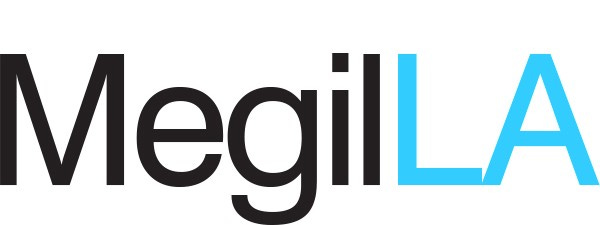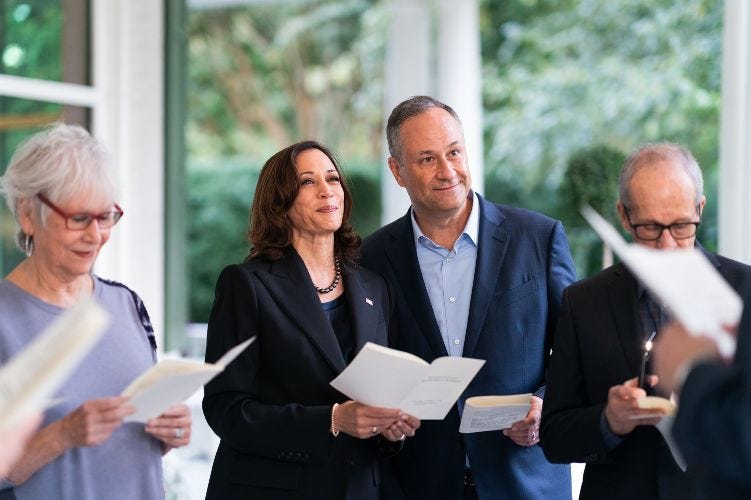Views of Summertime Jews
A New Scroll of LA Jewish News
Folks
On too many recent days, the words of Irving Berlin’s “God Bless America” seemed so distant. We seldom saw the “oceans white with foam,” and on many days could barely see the “light from above.” So, we went down to the sea, got into a boat in Oxnard Harbor, and in one hour were on Anacapa Island, part of Channel Islands National Park. On our daytrip to this volcanic rock, where the seagulls are the majority, we hiked around their nesting areas, listened to their calls of reproductive freedom, and marveled how they can return to the same nesting spot year after year. We dropped into the water of a sunlit cove, and staring through masks saw a golden kelp forest and the creatives who swim through it. At a point where we could look out on the island’s rocky, mountain spine, and hear the sea lions below, we were inspired to remember what it was like to call a place "home sweet home."
I hope this issue of MegilLA will inspire you to support it. Please be a friend of this publication, be a paid subscriber.
Shabbat shalom
Edmon J. Rodman
////\/\\\\
////\/\\\\
GUIDE FOR THE JEWPLEXED
Will the White House finally
be home sweet heym?
At the Naval Observatory in Washington D.C, the traditional home for U.S. vice presidents, second gentleman Douglas Emhoff, with VP Kamala Harris watching, hangs the building's first mezuzah, in 2021. Photos First Gentleman/X
Edmon J. Rodman
Come 2025, there will be a vacancy at the White House, and miracle of miracles, a Jew might move in. If his wife, probable Democratic nominee for president, Vice President Kamala Harris, wins in November, second gentleman, and longtime Angeleno, Douglas Emhoff, would be the first Jew to call the White House home.
His prospective new heym on 1600 Pennsylvania Ave., though a bit of a fixer-upper, has 132 rooms, including 16 family and guest rooms, 3 kitchens, and 35 bathrooms, a floor area of 55,000 square feet, sits on 18 acres, and is in walking distance to a D.C. bagel shop. What’s not to like?
So what if it has taken over 220 years for a Jew to live there, the new First Couple can make up for lost time.
Since Emhoff and Vice President Harris nailed a mezuzah to the front doorpost of their official home, the Naval Observatory (a first), and have hosted Rosh Hashanah gatherings, a Passover seder, and Hanukkah party there as well, we can expect a similar embrace of Jewish joy at their future home.
Asking the White House chef to bake challah every Friday would be an easy first, and building a sukkah in the Rose Garden a nice green touch.
Jews are known for their hospitality, and Emhoff, who had a bar mitzvah, and fondly remembers the Jewish holidays, would have ample opportunity to practice it in his new home. Imagine lighting Shabbat candles with officials who are Christian Nationalists. Or sitting down for a little Torah study with members of Congress who have barely enough Jews to make a minyan living in their districts.
A Freedom Seder with Volodymyr Zelenskyy as guest of honor, would lift his spirits, and make the news.
Photo First Gentleman/X
Over the 20th century, it has become common for first persons to promote a specific cause. Barbara Bush promoted literacy, and Nancy Reagan founded “Just Say No.” Hillary Clinton tried to reform the health care system, and Michelle Obama supported military families.
With all that space, Emhoff can spread out, and use the White House as a base for whatever cause he chooses, like his current one: getting the word out about the rise in antisemitism. Or, he could angle for something new, like the protection of herring fisheries.
One of the many duties assigned to the first person is decorating the White House for the holidays each year. Jackie Kennedy was the founder of this tradition. In 1961, she chose Tchaikovsky’s “Nutcracker” as her theme, and Emhoff could chose Jewish music as his.
With so many holiday songs written by Jewish composers and lyricists, how could this be a miss? Who could argue with Irving Berlin’s “White Christmas,” as a decorating theme? Allan Sherman’s “The Twelve Gifts of Christmas,” with its mention of transistor radios, could be viewed as a boost to the U.S. vintage market.
Adam Sandler’s “Eight Crazy Nights,” might also work, especially if you imagine the White House walls filled with photos of the famous Jewish Americans mentioned in the song.
As for the White House itself, first persons, have left their mark. Michelle Obama refurbished the Old Family Dining Room, and added a vegetable garden to the White House acreage. Hillary Clinton, put a collection of paintings, ceramics, and glassworks on display to highlight the country’s artists. Melania Trump built a tennis pavilion on the South Lawn.
Though constructing a mikveh in the White House basement might result in a Congressional investigation, some additions to the White House cuisine, like Emhoff’s favorites, latkes, kugel, matzah brei, and pastrami, might be cause for a cultural medal, or as impetus for a report on antacids.
The first gentleman could also put important historic documents such as George Washington’s letter “To the Hebrew Congregation in Newport, Rhode Island,” on display.
Written in 1790, the letter, probably quoting from the Book of Micah, both reassured and bestowed a blessing on the Jews of the new nation. “May the Children of the Stock of Abraham, who dwell in this land,” it said, “continue to merit and enjoy the good will of the other Inhabitants; while every one shall sit in safety under his own vine and figtree, and there shall be none to make him afraid.”
As there is a fig tree on the White House grounds, hopefully, come 2025, Douglas Emhoff and Kamala Harris can sit beneath its branches in peace.
////\/\\\\
NEW PLAY
Leni meets Mickey
Coinciding with the opening of the Paris Olympics, the world premiere of “Crevasse,” a play by Tom Jacobson, that looks at the rise of fascism and antisemitism in pre-war Germany, and its effect on art and its makers, will open July 26 at the Victory Theatre in Burbank.
In 1938, German filmmaker Leni Riefenstahl went to Hollywood to find American distribution for her award-winning film, “Olympia," a documentary about the Berlin 1936 Summer Olympics, held under the rule of Hitler. Only one studio head would meet with her: Walt Disney.
“In November 1938 there was public outcry about Germany, but full details were not yet known,” said Matthew McCray, the play’s director. “This was just after Kristallnacht, years before the U.S. officially entered the war.”
Ann Noble and Leo Marks star in this story of betrayal, Nazi propaganda and cartoons, based on an actual event.
A co-production of Son of Semele and The Victory Theatre Center, “Crevasse” runs through August 18. Tickets & Info
////\/\\\\
* Live from the Archive:
Lillian and the 20th try
U.S. Olympian Lillian Copeland, competing in women’s discus, 1932 Summer Olympics in Los Angeles. Color photo card (4.5” x 6.5”), published in Germany.
On the last day of the 1932 Summer Olympics, Jewish Angeleno, Lillian Copeland demonstrated record-breaking athletic prowess with her final throw in the women’s discus competition at Memorial Coliseum.
In the 1928 Amsterdam Olympics she had won a silver medal in the same event. Before that, in 1926, as a sophomore at USC (she was inducted into the USC Athletic Hall of Fame in 2003), she set national marks in the shot put and discus. She also held National Amateur Athletic Union crowns in shot put, discus throw, and javelin throw.
“She was one of the greatest overall woman athletes in the 1920’s,” said a biography in the Jewish Women’s Archive. (She was inducted into the Southern California Jewish Sports Hall of Fame in 1990.) Even earlier, she was involved with athletics at Los Angeles High School.
Born in New York City on November 25, 1904, Copeland was the daughter of Minnie Drasnin, a housewife, from Grodno, Poland. Lillian’s father died when she was young, and after her mother remarried, Abraham Copeland, manager of a produce company, they moved to Los Angeles.
The Los Angeles Times in their Olympics coverage on August 3, 1932, described Copeland, who was enrolled in USC Law School, as a “girl law student,” and as a “big, stocky woman.” (By today’s standards she looks athletic and fit).
“Nineteen times the discus misbehaved in her hands. Nineteen times she failed to get the stance and proper ‘feel’ to her throw,” the paper reported.
“I kept throwing but couldn’t seem to get warmed up,” Copeland told the Times.
Then, on the 20th throw, she won the gold medal, becoming a world champion as well. With “tears streaming down her face,” she walked from the field, “the great ambition of her life fulfilled,” said the paper.
As she walked from the field, it was her last Olympics, as she boycotted the Germany Games in 1936.
Afterward, Copeland returned to USC Law School, and eventually took a job as an officer with the L.A. County Sheriff’s Department in 1936, working 24 years in the Juvenile Bureau at the Firestone,and Lennox stations; rising to the rank of sergeant. She died in 1964 after a lengthy illness.
As a kind of memorial to her achievement, on the wall of Canter’s parking lot, there’s a painted image of Copeland in an athletic Jersey and shorts revving up to throw a discus. Next time you visit Canter’s, you can pay your respects.
*The Rodman Archive of Los Angeles Jewish History is a collection of approximately 1000 objects, photos, clothing, art, books, recordings, and ephemera relating to the lives and endeavors of Jewish Angelenos between 1850 and 1980.
////\/\\\\
Seen on the way:
Los Angeles County Museum of Art
“Norms, La Cienega, On Fire,” 1964, Edward Ruscha, on display at LACMA.
Norms, La Cienega. Photo EJR
Was there a grease fire at Norms on La Cienega? No, but in 1964 artist Edward Ruscha (pronounced roo-SHAY) was seeing flames when he painted “Norms, La Cienega, On Fire,” a work now on display on the second floor of the Broad Museum of Contemporary Art at LACMA as part of a retrospective of the Culver City artist’s work. Though the piece graphically connects the flames with the restaurant’s iconic logo, what it does not reveal is the man behind the name. Norman Roybark, son of Russian Jewish immigrants, was, in 1949, the founder of Norms. His Googie-style restaurants, designed with expansive front windows, resemble mid-century automobile showrooms, and for good reason. In the 1920s, Roybark went into the used car business with his brother, and later, opened several car lots of his own. In 1948, he was known well-enough in LA’s Jewish community to be named co-chair of the United Jewish Welfare Fund’s auto sales and finance division. The following year, when he took over a small building adjacent to his car lot in Hollywood, it became the first Norms. The eye-catching Norms pennant sign, reminiscent of the flags that often fly around used car lots, and mimicked by Ruscha’s pointed flames, was a co-creation of Roybark and architect Eldon Davis.
////\/\\\\




